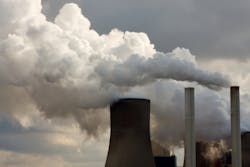Scientists Deploy Mikrotron Camera to Limit Dangerous Coal Combustion
Despite a negative impact on the natural environment, coal still represents 27% of global energy consumption. To minimize emissions into the atmosphere from burning coal, sophisticated combustion technologies are used that require constant maintenance to their burners' fuel-to-air ratio. Flame imagery is the primary source of data for those responsible for maintaining combustion at ideal conditions. Monitoring flames with cameras means there is no delay in obtaining results, as there is with analysis of flue gases. This method is also non-invasive, and flame information captured by cameras has controlled spatial resolution.
In a recent study conducted by the Faculty of Electrical Engineering and Computer Science of Lublin University of Technology in Lublin, Poland, researchers devised a method combining flame image processing with a deep convolutional neural network (DCNN) that ensures high accuracy of identifying undesired combustion states.
In the study, flames were recorded by a Mikrotron color camera with a full-frame transfer matrix equipped with a CameraLink interface. The camera features a CMOS image sensor with a resolution of 1,280 × 1,024 pixels, a dynamic range of 59 dB, sensitivity of 1,600 bit/lux⋅s at 550 nm, and acquisition speed of 500 frames per second (fps) at full resolution.
The Mikrotron camera was attached to a high-temperature borescope installed in the chamber sight glass at an angle of approximately 45-deg. to the burner’s axis. Image frames of 800 × 800 pixels were recorded in RGB mode with 24-bit color depth.
During recording, a fixed exposure time and a frame rate of 500 fps were maintained. Video recordings for individual combustion variants were saved in mass storage in lossless AVI files, with the duration of each recording being 300 seconds. All operations related to image processing were performed using Python 3.7.3 and libraries OpenCV 3.4.1 and NumPy 1.16.4.
Using DCNN, researchers devised a method to limit the amount of uncontrolled air that gets into coal combustion chambers, a phenomenon that changes the standard or effective value of the excess air coefficient. When excessive air is in the chamber the combustion conditions are altered, and the fuel ceases to be completely incinerated. However, if engineers can be made aware of the new undesirable state by viewing flame images, they can quickly restore the normal conditions of the combustion process. In doing so, coal-burning operations limit emissions tied to greenhouse gases, acid rain, and respiratory illnesses.
The researchers at the Lublin University of Technology found they could obtain this critical information by analyzing and classifying flame images using the Mikrotron camera combined with DCNN, in one of the first instances of deep learning algorithms being used to solve this type of problem. Their method significantly simplifies the stage of image data processing compared to traditional machine learning algorithms because stages such as data pre-processing, feature engineering, feature extraction, and feature selection are eliminated.
The DCNN can reveal the internal features of individual combustion states based on raw data obtained from images while ensuring high classification efficiency. Additionally, the relatively low consumption time of the method opens up the possibility for its use in industrial combustion systems.
